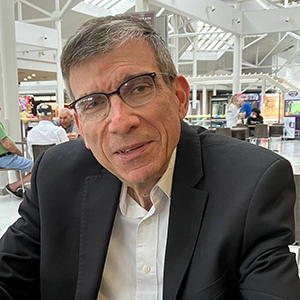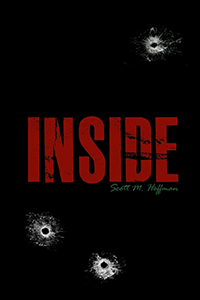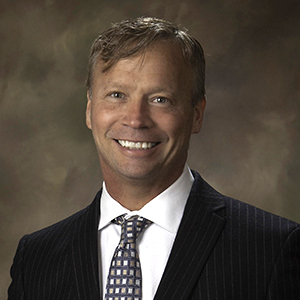Interview with Scott M. Hoffman


Scott M Hoffman
author of "Inside"

Michael Carter
Co-Host
Scott M Hoffman, author of "Inside"
Scott M Hoffman's Website
Scott M. Hoffman was a witness to historical events concerning major mob families. He learned the inner workings from his dad, who loyally served The Outfit for over 55 years – never spending a day in prison. Now 74, he is a native of Chicago. He is a graduate of Long Island University-Brooklyn with a B.A. in Journalism. For 35 years he worked for the City of Chicago in the Departments of Purchasing and Finance. Inside is his first published book.
Scott Hoffman is not a name that is listed in any court records or historical documents about the Mafia. But, he was in the room when meetings took place, he saw street enforcers and juice collectors deal out punishment, and he interacted with the real Goodfellas and Godfathers, including notorious gangsters Henry Hill, Tony Accardo, and Sam Giancana.
He witnessed his first murder as a little boy – and was asked to get rid of the .22 silencer. He worked during college at social clubs run by The Lucchesi, Columbo, and Bonnano crime families.
And he heard many stories from his father, who spent over 55 years in the family business, rising up to be a consigliere for Giancana. Scott had to make a decision when he graduated college – would he live a straight and clean life – or would he spend his whole life being chased by the FBI, competing mobsters, and fellow gangsters. His book is a work of historical fiction that ties in true events and real hitmen – and tells a unique story of the hardships, consequences, and rewards of living “the life.”
Inside by Scott M. Hoffman reads like a movie It is an intriguing work detailing the internal workings of the Outfit, an organized crime family, which originated on the South Side of Chicago during prohibition and rose to power in the 1920s. The Outfit has been involved in a wide variety of criminal activities including gambling, loan-sharking, prostitution, drug trafficking, money laundering, extortion, labor racketeering, adult and child pornography, political corruption, and murder. The individuals and events in Inside are composites of real people and real events.
Inside begins in 1956 with Jimmy Williams, a 47-year-old man with two families-his wife and two children and the Outfit. He’s a good man, a good husband, and a good father, while, at the same time, he is a physically powerful man who is well respected as a consigliere in the Outfit. He keeps his two lives separated, to the point his wife is unaware of what he does.
The story is written from the perspective of Jimmy’s son Bobby who, from the age of 8 begins to accompany his father on Outfit business. Jimmy wants him to know what “the life” is like in order for Bobby to decide if this is the future that he wants for himself. Take this remarkable journey with Bobby. Will he follow in his father’s footsteps or choose another path?
The Chicago Outfit (also known as the Outfit, the Chicago Mafia, the Chicago Mob, the Chicago crime family, the South Side Gang or The Organization) is an Italian-American organized crime syndicate or crime family based in Chicago, Illinois, that originated in the city’s South Side in 1910. It is part of the larger Italian-American Mafia.
The Outfit rose to power in the 1920s under the control of Johnny Torrio and Al Capone, and the period was marked by bloody gang wars for control of the distribution of illegal alcohol during Prohibition. Since then, the Outfit has been involved in a wide range of criminal activities, including loansharking, illegal gambling, prostitution, extortion, political corruption and murder. Capone was convicted of income tax evasion in 1931 and the Outfit was next run by Paul Ricca. He shared power with Tony Accardo from 1943 until his death in 1972; Accardo became the sole power in the Outfit upon Ricca’s death and was one of the longest sitting bosses of all time upon his death in 1992.
Though it has never had a complete monopoly on organized crime in Chicago, the Outfit has long been the most powerful, violent and largest criminal organization in Chicago and the Midwest in general. Unlike other mafia factions such as the Five Families of New York City, the Outfit has been a unified faction since its conception.[9] Its influence at its peak stretched as far as California, Florida and Nevada and it continues to operate throughout the Midwestern United States and Southern Florida, as well as Las Vegas and other parts of the Southwestern United States. Heightened law enforcement attention and general attrition have led to its gradual decline since the late 20th century, though it continues to be one of the major and most active organized crime groups in the Chicago metropolitan area and the Midwestern region.
The early years of organized crime in Chicago, in the late 19th and early 20th centuries, were marked by the division of various street gangs controlling the South Side and North Side, as well as the Black Hand organizations of Little Italy. In later years, the Outfit consisted of various street crews controlling different territories around Chicago including Elmwood Park, Melrose Park, Chicago Heights, Rush Street, Grand Avenue and Chinatown.
Big Jim Colosimo centralized control in the early 20th century. Colosimo was born in Calabria, Italy, in 1878, immigrated to Chicago in 1895, where he established himself as a criminal. By 1909, with the help of bringing Johnny Torrio from New York to Chicago, he was successful enough that he was encroaching on the criminal activity of the Black Hand organization. Colosimo, also “cultivated deep political connections” after “serving as a precinct captain in the organization of First Ward Alderman Couglin and Kenna, and later [became] the bagman (collector of illegal profits and dispenser of bribes) in the vice-laden Levee District, which afforded him with blanket political protection.”
During the 1960 presidential election, many claim that the Mafia, and in particular, the Chicago Outfit, boosted candidate and president John F. Kennedy. The strategy for boosting votes for Kennedy essentially ran through the mafia-controlled unions, physically threatening those who did not vote for Kennedy. It was even said that Joseph Kennedy held a meeting with mob boss Sam Giancana before the election.[43] Supposedly the Kennedys and the Mafia agreed that if John were elected president, he would lighten the pursuit of authorities on the mob group.
However, after the election, President Kennedy turned on Giancana. Theories say this is what led to his and Robert Kennedy’s assassination. Further, many believe the Outfit was involved in a Central Intelligence Agency–Mafia collusion during Castro’s overthrow of the Cuban government. In exchange for its help, the Outfit was to be given access to its former casinos if it helped overthrow Fidel Castro in Operation Mongoose or Operation Family Jewels.[44] The Outfit failed in that endeavor and faced increasing indictments under the administration of President John F. Kennedy (JFK).
The Outfit reached the height of its power in the early 1960s. Accardo used the Teamsters pension fund, with the aid of Meyer Lansky, Sidney Korshak, and Jimmy Hoffa, to engage in massive money laundering through the Outfit’s casinos. The 1970s and 1980s were a hard time for the Outfit, as law enforcement continued to penetrate the organization, spurred by poll-watching politicians. Off-track betting reduced bookmaking profits, and illicit casinos withered under competition from legitimate casinos. Activities such as auto theft and professional sports betting did not replace the lost profits.
The Outfit controlled casinos in Las Vegas and “skimmed” millions of dollars over the course of several decades. Most recently, top mob figures have been found guilty of crimes dating back to as early as the mid-1960s. It has been rumored that the $2 million skimmed from the casinos in the Court case of 1986 was used to build the Old Neighborhood Italian American Club, the founder of which was Angelo J. “The Hook” LaPietra.
Allen Dorfman, a key figure in the Outfit’s money embezzlement operations, was investigated by the Department of Justice. In 1982, the FBI wire-tapped Dorfman’s personal and company phone lines and was able to gather the evidence needed to convict Dorfman and several of his associates on attempts to bribe a state senator to get rid of the trucking industry rates. If Dorfman succeeded, the Outfit would have seen a huge gain of profit. This was known as Operation Pendorf and was a huge blow to the Chicago crime syndicate.[45]
Operation GAMBAT (Gambling Attorney) proved to be a crippling blow to the Outfit’s tight grip on the Chicago political machine. Pat Marcy, a made man in the Outfit, ran the city’s First Ward, which represented most of downtown Chicago. Marcy and company controlled the circuit courts from the 1950s until the late 1980s with the help of Alderman Fred Roti and Democratic Committeeman John D’Arco Sr. Together, the First Ward fixed cases involving everything from minor traffic violations to murder.
Attorney and First Ward associate Robert Cooley was one of the lawyers who represented many mafiosi and associates in which cases were fixed. As a trusted man within the First Ward, Cooley was asked to “take out” a city police officer. Cooley was also an addicted gambler and in debt, so he approached the U.S. Justice Department’s Organized Crime Strike Force, declaring that he wanted to “destroy Marcy and the First Ward”.
Cooley was soon in touch with the FBI and began cooperating as a federal informant. Through the years, he maintained close ties to Marcy and the big shots of the First Ward. He wore an electronic surveillance device, recording valuable conversations at the notorious “First Ward Table”, located at “Counselor’s Row” across the street from Chicago City Hall. The results in Operation GAMBAT (Gambling Attorney) were convictions of 24 corrupt judges, lawyers, and cops.
Accardo died in 1992.[46] In a measure of how successfully he had managed to stay out of the limelight, he never spent a day in jail (or only spent one day, depending on the source) despite an arrest record dating to 1922. Chicago’s transition from Accardo to the next generation of Outfit bosses has been more of an administrative change than a power struggle, distinct from the way that organized crime leadership transitions take place in New York City.